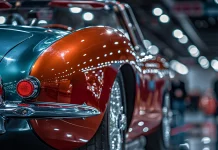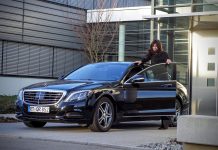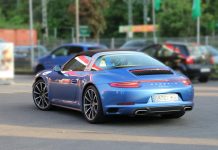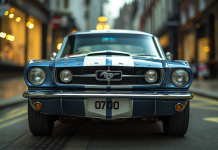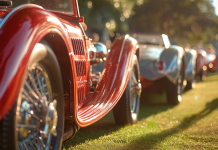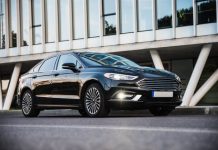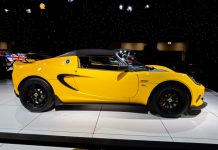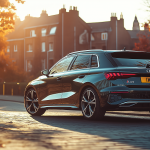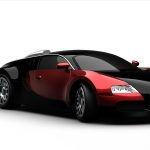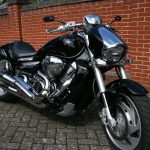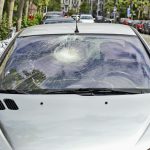New Michelin Pilot Super Sport tyre track tested
Monday, 9 May 2011 4:45 PM

The luscious Lamborghini Gallardo. Just one of the supercars on hand to put the new Michelin Pilot Super Sport tyre through its track-paces on the recent UK launch
Top-end tyres – like the all-new Michelin Pilot Super Sport – are for top-end cars, right? Well, yes; the latest high performance tyre from Michelin is indeed designed to grace the big rims of some of the finest and fastest auto-exotica from street and track, but thanks to new and impressive levels of grip, all-weather usability and, most importantly, reduced wear rate; the Pilot Super Sport actually becomes an option for the fast-road and track day fans out there that want to go quick, without burning through stacks of the expensive sticky stuff.
In the real world it’s your tyres, brakes and suspension that shave the seconds, rather than just incredible power. Sure, big bhp is a big part of any truly juicy performance package, but if your grip system isn’t up to the task then all that power is wasted on wheelspin, early braking and out-of-shape cornering.
Certain OAP-presented BBC TV shows will tell you that big-dollar supercars are fab; gibbering grins plastered across wrinkled faces as they dispatch yet another set of expensive black rubber rings to the smouldering tyre graveyard in the sky, via mile-high plumes of smoke. But that’s all about as real-world as Shakira ironing your undies.
Back on planet Earth and you might’ve just spent £6,000 of your hard-earned wages on a tidy, track-tweaked BMW M3 E36; a 300bhp, finely balanced Bavarian rear-driving treat that delivers much to the performance-man-in-the-street for a budget that’s not knocking on NASA’s door.
You’ve been enjoying your new Beemer on the street and your mates think you’re the man, but now you want to really stretch those M3 legs. Track time. A few minutes in and the BM is greedily lapping up the hot laps with directed turn-in, great corner grip and enough grunt for a cheeky sideways tweak out of the hairpin. But back in the pits and your tyres are shot. The cost and quick wear rate of track-ready, road legal rubber always kept me away from track days. So let’s take a look at how the Pilot Super Sport addresses this issue.
According to Michelin and compared to their last top-end tyre; the Pilot Sport 2, the new Super Sport delivers 50 per cent more track mileage. 50%! My ears pricked up during the presentation for the new Super Sport tyre at Porsche’s Driving Experience Centre, nestled within the Silverstone circuit walls. Super Sport-shod 911s and Caymans are to be our tyre testbeds after the Michelin main-man has made his speech; putting their money where their marketing-mouth is, you could say.
Until now, track wear has been the main cost-barrier to my track fun – I just can’t afford to burn a new set of tyres in an afternoon, and while the new Michelins won’t be cheap; if I can drive to the track, lap for laughs for the afternoon, and then drive home on safe and legal rubber I’m definitely interested.
This Michelin presentation gives me further insight into the time, effort and tech that goes into something we can tend to take for granted – until we come to pay for them at least – and it’s clear that the Michelin team can’t wait for the assembled motoring press-peeps to lap-prove their new product. They’re expecting their near £500 million yearly spend on R&D to pay off.
I won’t bore you with all the details, but rest assured that these new hoops are intended – after manufacturer partnership testing; with Porsche, for example – to be factory supplied equipment on some very quick cars. Again, compared to its predecessor, the Super Sport seems to stack up for even the budget-conscious grip-fanatic.
Here are the new Super Sport stats:
– Total mileage on the road is improved by ten per cent.
– Fifty per cent more laps on the track.
– Dry surface road-holding testing showed a 1.5sec gain per lap over a 2,700 metre circuit.
– Dry surface braking from 62mph to a full stop showed braking distance reduced by 1.5 metres.
– Wet surface braking from 50mph to 6mph show braking distance reduced by three metres.
– Wet surface road-holding testing showed a 2.5secs gain per lap over a 4,100 metre circuit.
Some impressive-sounding stats from Michelin, but is it all backed-up by tech? Well, here it is:
– Twaron belt. Wrapped around the tyre under the grip compound is a belt made of a light and strong material called Twaron. Michelin wrapped the belt at different thicknesses across the surface of the tyre carcass to accurately control the tyre’s expansion as rotation speeds increase. Without the controlling accuracy of the belt, at big speeds, you could see an expansion in the middle of the tyre’s contact patch that effectively reduces the contact patch width. The Twaron belt works to keep the contact patch flat across the entire width of the Super Sport. More contact patch equals more grip.
– Bi-compound tread. Originally developed for racing tyres – Michelin have been successful in motorsport for 100 years – this technology uses different rubber compounds on the left and right sides of the tread. On the outside, a unique, carbon black-reinforced elastomer (or elastic polymer; rubber) – developed specifically for the 24 Hours of Le Mans endurance race – offers better tyre endurance when cornered hard. On the inside of the tread, a latest-generation, high-grip elastomer enables the tyre (on wet surfaces) to break through the water’s surface, pressing the tyre onto the grip of the tarmac. Harder on the outside cornering edge that gets a battering through the bends, and softer on the inside edge for wet grip.
– Variable contact patch. Your tyre can only give you grip when the tread is in contact with the road; known as the contact patch. Using the latest digital simulation software Michelin has designed the Super Sport to spread rubber-wearing higher temperatures evenly across the tyre’s contact patch. Although the contact patch’s shape changes when cornering, the amount of rubber in contact with the road is designed to remain constant.
It all looks pretty good on paper. But what about on the black-top, where it really counts?
Michelin supplied us with various Porsche models to put the Super Sport through its paces; in dry, wet, handling, and hard braking situations, on a specially designed system of tracks on the Silverstone estate. And probably the most crucial to our average track day fan, and the most noticeable for this mid-experience driver, was some fast laps in the current model 911 Carrera 2, packing a 3.8-litre, 385bhp flat-6 engine.
We’re out on a the new Super Sport to start and with a Porsche Driving Consultant alongside I head out onto what is best described as an undulating, blind-cornered, good-size go-kart track – not so large as to see 100mph offs, but tight and twisting with varying cambers to simulate a blast on our favourite back lanes.
The 911 is seriously happy in this situation; the rear-engine’d, rear-driving German machinery was honed to perfection in this very circumstance, and while the new Super Sport is not yet Porsche approved, Michelin fully expects it to be by August 2012.
With the up-spec carbon ceramic brakes warmed I start to push the pace, and while yes, a new 911 is truly a maestro of mechanical grip, I feel immediately at home scything through the series off-camber, on-camber, blind-crest bends.
The Porsche instructor starts to explain the correct apex-lines and I’m relaxed and in-the-groove enough to discuss these finer racing points without losing concentration; even as the lap pace continues to build and build.
I get the grip every time I ask for it with the car feeling planted under me and my inputs faithfully reproduced, and interestingly, none of the squeal and chirrup usually associated with quick laps on road tyres. Now I’m feeling cocky.
The ceramic brakes are incredible; no matter how late and hard I brake the 911 always hits the apex I want, and even some fairly ham-footed, mid-bend accelerating only ends up with the merest twitch at the back-end. Now I’m not a tyre-tester but the fact that after a few settling laps I’ve almost forgotten that we’re testing tyres is a testament to the Super Sports easy usability.
It’s only when ambition finally outweighs talent and the instructor asks me to reign it in a bit, informing me that it was only the complex and clever PSM (Porsche Stability Management) that kept this brand new motor out of the armco; that I’m sharply shown that it’s the tyres and the car that are actually the stars of these pretty quick laps.
If you’re a regular racer or track-dayer then you’ll want to try out and to understand these new Michelins for yourself, but for us laymen out there I can tell you that the Super Sports delivered great dry grip. Then we jumped in the same car wearing some top-end tyres from the competition.
Into the first bend with the same bravado and I’m in for a heart-stopping surprise. The grip, composure and anti-tyre-roll of the Super Sport are all gone. All I get as I wash through the bend, eyes wide and palms instantly sweating, is a squeal of hard-pushed rubber and a 911’s nose that wants to push wide on an afternoon date with a not so sexy crash barrier.
As I rather frantically gather up the wandering Porsche; my confidence freshly on the floor, my instructor gives me a wry smile and probably once again offers a silent prayer of thanks to the Gods of Porsche traction electronics.
This distinctly unscientific-feeling test actually presents distinctly night and day results – from novice to mid-level, and all the way to professional; the difference between the Michelins and their competitor tyres which, by the way, were all supplied off the shelf, is easily noticeable; regardless of how precise and experienced the driver inputs. We all want grip.
The same goes for the braking and wet handling tests; the Super Sport stopped and gripped better in all conditions, and most notably, the emergency braking test – that could apply to all of us on the road every day – the Super Sports gave the kind of dig-in grip that forced the breath from my lungs; stopping the car shorter than the competition’s rubber every time.
So, if you want to hone your skills – budget-consciously – on the track, shoe your Prancing Horse with some serious grip, or want the peace of mind of shorter braking distances; the latest Michelin Pilot Super Sport tyre is certainly worth a spin.

Porsche 911 Turbo. Open the 530bhp taps on one of these and you'll be thankful for pukka tyres!

A rack of Porsches, some with the new Michelin Pilot Super Sport tyres, some with the competition. Tested side-by-side on the track and the difference is night and day

Blue meanie

Michelin translate their huge Le Mans endurance racing experience into road tyres that grip and last; wet or dry


Silverstone; the home of British motorsport and a very fine facility for tyre testing

We didn't need these

Porsche laid on the cars, and the experience, in style

Cheers mate, and congratulations on a job well done!
www.michelin.co.uk
Words & pics: Daniel Anslow
Follow us @totallymotor


